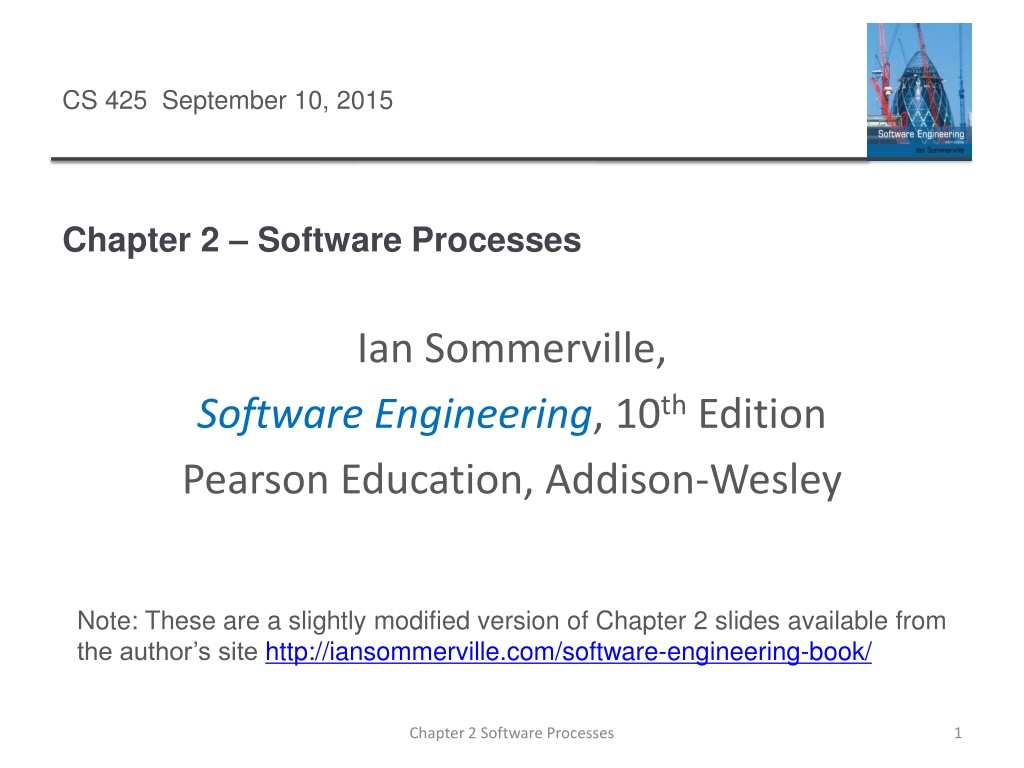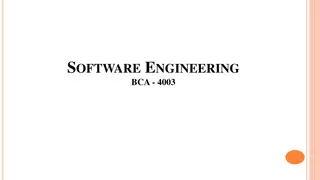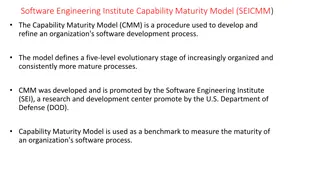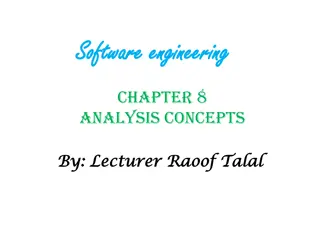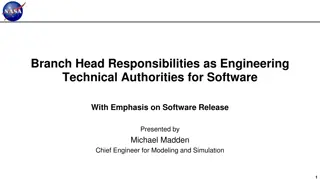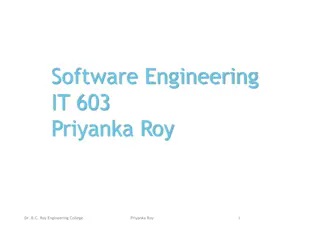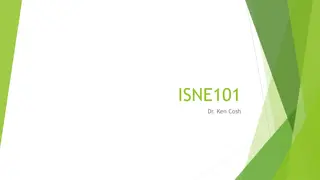Understanding Software Processes in Software Engineering
Exploring software processes, this content delves into topics like software process models, process activities, handling change, and process improvement. It discusses the structured set of activities involved in developing a software system, various process descriptions, plan-driven versus agile processes, and software process models like the waterfall model.
Uploaded on Oct 10, 2024 | 0 Views
Download Presentation

Please find below an Image/Link to download the presentation.
The content on the website is provided AS IS for your information and personal use only. It may not be sold, licensed, or shared on other websites without obtaining consent from the author. Download presentation by click this link. If you encounter any issues during the download, it is possible that the publisher has removed the file from their server.
E N D
Presentation Transcript
CS 425 September 10, 2015 Chapter 2 Software Processes Ian Sommerville, Software Engineering, 10th Edition Pearson Education, Addison-Wesley Note: These are a slightly modified version of Chapter 2 slides available from the author s site http://iansommerville.com/software-engineering-book/ Chapter 2 Software Processes 1
Topics covered Software process models Process activities Coping with change Process improvement Chapter 2 Software Processes 2
The software process Software process: a structured set of activities required to develop a software system Many different software processes but all involve: Specification defining what the system should do; Design and implementation defining the organization of the system and implementing the system; Validation checking that it does what the customer wants; Evolution changing the system in response to changing customer needs. A software process model is an abstract representation of a process. It presents a description of a process from some particular perspective. Chapter 2 Software Processes 3
Software process descriptions When we describe and discuss processes, we usually talk about the activities in these processes such as specifying a data model, designing a user interface, etc. and the ordering of these activities. Process descriptions may also include: Products, which are the outcomes of a process activity; Roles, which reflect the responsibilities of the people involved in the process; Pre- and post-conditions, which are statements that are true before and after a process activity has been enacted or a product produced. Chapter 2 Software Processes 4
Plan-driven and agile processes Plan-driven processes are processes where all of the process activities are planned in advance and progress is measured against this plan. In agile processes, planning is incremental and it is easier to change the process to reflect changing customer requirements. In practice, most practical processes include elements of both plan-driven and agile approaches. There are no right or wrong software processes. 30/10/2014 Chapter 2 Software Processes 5
Software process models Chapter 2 Software Processes 6
Software process models The waterfall model (1) Plan-driven model. Separate and distinct phases of specification and development. Incremental development (2) Specification, development and validation are interleaved. May be plan-driven or agile. Integration and configuration (3) The system is assembled from existing configurable components. May be plan-driven or agile. In practice, most large systems are developed using a process that incorporates elements from all of these models. Chapter 2 Software Processes 7
The waterfall model Chapter 2 Software Processes 8
Waterfall model phases There are separate identified phases in the waterfall model: Requirements analysis and definition System and software design Implementation and unit testing Integration and system testing Operation and maintenance The main drawback of the waterfall model is the difficulty of accommodating change after the process is underway. In principle, a phase has to be complete before moving onto the next phase. Chapter 2 Software Processes 9
Waterfall model problems Inflexible partitioning of the project into distinct stages makes it difficult to respond to changing customer requirements. Therefore, this model is only appropriate when the requirements are well-understood and changes will be fairly limited during the design process. Few business systems have stable requirements. The waterfall model is mostly used for large systems engineering projects where a system is developed at several sites. In those circumstances, the plan-driven nature of the waterfall model helps coordinate the work. Chapter 2 Software Processes 10
Incremental development Chapter 2 Software Processes 11
Incremental development benefits The cost of accommodating changing customer requirements is reduced The amount of analysis and documentation that has to be redone is much less than is required with the waterfall model It is easier to get customer feedback on the development work that has been done Customers can comment on demonstrations of the software and see how much has been implemented More rapid delivery and deployment of useful software to the customer is possible Customers are able to use and gain value from the software earlier than is possible with a waterfall process Chapter 2 Software Processes 12
Incremental development problems The process is not visible Managers need regular deliverables to measure progress. If systems are developed quickly, it is not cost-effective to produce documents that reflect every version of the system System structure tends to degrade as new increments are added Unless time and money is spent on refactoring to improve the software, regular change tends to corrupt its structure. Incorporating further software changes becomes increasingly difficult and costly Chapter 2 Software Processes 13
Integration and configuration Based on software reuse where systems are integrated from existing components or application systems (COTS - commercial-off-the-shelf). Reused elements may be configured to adapt their behaviour and functionality to a user s requirements Reuse is now the standard approach for building many types of business system Reuse covered in more depth in Chapter 15 Chapter 2 Software Processes 14
Types of reusable software Stand-alone application systems (sometimes called COTS) that are configured for use in a particular environment. Collections of objects that are developed as a package to be integrated with a component framework such as .NET or J2EE. Web services that are developed according to service standards and which are available for remote invocation. 30/10/2014 Chapter 2 Software Processes 15
Reuse-oriented software engineering Chapter 2 Software Processes 16
Key process stages Requirements specification Software discovery and evaluation Requirements refinement Application system configuration Component adaptation and integration Chapter 2 Software Processes 17
Advantages and disadvantages Reduced costs and risks as less software is developed from scratch Faster delivery and deployment of system But requirements compromises are inevitable so system may not meet real needs of users Loss of control over evolution of reused system elements Chapter 2 Software Processes 18
Process activities Chapter 2 Software Processes 19
Process activities Real software processes are inter-leaved sequences of technical, collaborative and managerial activities with the overall goal of specifying, designing, implementing and testing a software system The four basic process activities of specification, development, validation and evolution are organized differently in different development processes For example, in the waterfall model, they are organized in sequence, whereas in incremental development they are interleaved Chapter 2 Software Processes 20
The requirements engineering process Chapter 2 Software Processes 21
Software specification The process of establishing what services are required and the constraintson the system s operation and development Requirements engineering process Requirements elicitation and analysis What do the system stakeholders require or expect from the system? Requirements specification Defining the requirements in detail Requirements validation Checking the validity of the requirements Chapter 2 Software Processes 22
Software design and implementation The process of converting the system specification into an executable system Software design Design a software structure that realizes the specification Implementation Translate this structure into an executable program The activities of design and implementation are closely related and may be inter-leaved Chapter 2 Software Processes 23
A general model of the design process Chapter 2 Software Processes 24
Design activities Architectural design, where you identify the overall structure of the system, the principal components (subsystems or modules), their relationships and how they are distributed Database design, where you design the system data structures and how these are to be represented in a database Interface design, where you define the interfaces between system components Component selection and design, where you search for reusable components. If unavailable, you design how it will operate. Chapter 2 Software Processes 25
System implementation The software is implemented either by developing a program or programs or by configuring an application system Design and implementation are interleaved activities for most types of software system Programming is an individual activity with no standard process Debugging is the activity of finding program faults and correcting these faults Chapter 2 Software Processes 26
Software validation Verification and validation (V & V) is intended to show that a system conforms to its specification and meets the requirements of the system customer Involves checking and review processes and system testing System testing involves executing the system with test cases that are derived from the specification of the real data to be processed by the system Testing is the most commonly used V & V activity Chapter 2 Software Processes 27
Stages of testing Chapter 2 Software Processes 28
Testing stages Component testing Individual components are tested independently Components may be functions or objects or coherent groupings of these entities System testing Testing of the system as a whole. Testing of emergent properties is particularly important. Customer testing Testing with customer data to check that the system meets the customer s needs Chapter 2 Software Processes 29
Testing phases in a plan-driven software process (V-model) Chapter 2 Software Processes 30
Software evolution Software is inherently flexible and can change As requirements change through changing business circumstances, the software that supports the business must also evolve and change Although there has been a demarcation between development and evolution (maintenance) this is increasingly irrelevant as fewer and fewer systems are completely new Chapter 2 Software Processes 31
System evolution Chapter 2 Software Processes 32
Coping with change Chapter 2 Software Processes 33
Coping with change Change is inevitable in all large software projects Business changes lead to new and changed system requirements New technologies open up new possibilities for improving implementations Changing platforms require application changes Change leads to rework so the costs of change include both rework (e.g., re-analyzing requirements) as well as the costs of implementing new functionality Chapter 2 Software Processes 34
Reducing the costs of rework Change anticipation, where the software process includes activities that can anticipate possible changes before significant rework is required For example, a prototype system may be developed to show some key features of the system to customers Change tolerance, where the process is designed so that changes can be accommodated at relatively low cost This normally involves some form of incremental development. Proposed changes may be implemented in increments that have not yet been developed. If this is impossible, then only a single increment (a small part of the system) may have be altered to incorporate the change. Chapter 2 Software Processes 35
Coping with changing requirements System prototyping, where a version of the system or part of the system is developed quickly to check the customer s requirements and the feasibility of design decisions. This approach supports change anticipation. Incremental delivery, where system increments are delivered to the customer for comment and experimentation. This supports both change avoidance and change tolerance. Chapter 2 Software Processes 36
Software prototyping A prototype is an initial version of a system used to demonstrate concepts and try out design options A prototype can be used in: The requirements engineering process to help with requirements elicitation and validation In design processes to explore options and develop a UI design In the testing process to run back-to-back tests Chapter 2 Software Processes 37
Benefits of prototyping Improved system usability A closer match to users real needs Improved design quality Improved maintainability Reduced development effort Chapter 2 Software Processes 38
The process of prototype development Chapter 2 Software Processes 39
Prototype development May be based on rapid prototyping languages or tools May involve leaving out functionality Prototype should focus on areas of the product that are not well- understood Error checking and recovery may not be included in the prototype Focus on functional rather than non-functional requirements such as reliability and security Chapter 2 Software Processes 40
Throw-away prototypes Prototypes should be discarded after development as they are not a good basis for a production system: It may be impossible to tune the system to meet non-functional requirements Prototypes are normally undocumented The prototype structure is usually degraded through rapid change The prototype probably will not meet normal organizational quality standards Chapter 2 Software Processes 41
Incremental delivery Rather than deliver the system as a single delivery, the development and delivery is broken down into increments with each increment delivering part of the required functionality User requirements are prioritized and the highest priority requirements are included in early increments Once the development of an increment is started, the requirements are frozen though requirements for later increments can continue to evolve Chapter 2 Software Processes 42
Incremental development and delivery Incremental development (see earlier Software Process Model #3 slides 7 and 11-13) Develop the system in increments and evaluate each increment before proceeding to the development of the next increment Normal approach used in agile methods Evaluation done by user/customer proxy Incremental delivery (considered Software Process Model #4) Deploy an increment for use by end-users More realistic evaluation about practical use of software Difficult to implement for replacement systems as increments have less functionality than the system being replaced Chapter 2 Software Processes 43
Incremental delivery Chapter 2 Software Processes 44
Incremental delivery advantages Customer value can be delivered with each increment so system functionality is available earlier Early increments act as a prototype to help elicit requirements for later increments Lower risk of overall project failure The highest priority system services tend to receive the most testing Chapter 2 Software Processes 45
Incremental delivery problems Most systems require a set of basic facilities that are used by different parts of the system As requirements are not defined in detail until an increment is to be implemented, it can be hard to identify common facilities that are needed by all increments The essence of iterative processes is that the specification is developed in conjunction with the software However, this conflicts with the procurement model of many organizations, where the complete system specification is part of the system development contract Chapter 2 Software Processes 46
Process improvement Chapter 2 Software Processes 47
Process improvement Many software companies have turned to software process improvement as a way of enhancing the quality of their software, reducing costs or accelerating their development processes Process improvement means understanding existing processes and changing these processes to increase product quality and/or reduce costs and development time Chapter 2 Software Processes 48
Approaches to improvement The process maturity approach, which focuses on improving process and project management and introducing good software engineering practice The level of process maturity reflects the extent to which good technical and management practice has been adopted in organizational software development processes The agile approach, which focuses on iterative development and the reduction of overheads in the software process The primary characteristics of agile methods are rapid delivery of functionality and responsiveness to changing customer requirements Chapter 2 Software Processes 49
The process improvement cycle Chapter 2 Software Processes 50
